Proofpoint’s Threat Research team joined up with the Team Cymru S2 Threat Research team, in a collaborative effort to provide the information security community with a comprehensive view of the threat activity described.
Key takeaways
- Proofpoint first observed new malware named Latrodectus appear in email threat campaigns in late November 2023.
- While use of Latrodectus decreased in December 2023 through January 2024, Latrodectus use increased in campaigns throughout February and March 2024.
- It was first observed in Proofpoint data being distributed by threat actor TA577 but has been used by at least one other threat actor, TA578.
- Latrodectus is an up-and-coming downloader with various sandbox evasion functionality.
- While similar to IcedID, Proofpoint researchers can confirm it is an entirely new malware, likely created by the IcedID developers.
- Latrodectus shares infrastructure overlap with historic IcedID operations.
- While investigating Latrodectus, researchers identified new, unique patterns in campaign IDs designating threat actor use in previous IcedID campaigns.
Overview
Proofpoint identified a new loader called Latrodectus in November 2023. Researchers have identified nearly a dozen campaigns delivering Latrodectus, beginning in February 2024. The malware is used by actors assessed to be initial access brokers (IABs).
Latrodectus is a downloader with the objective of downloading payloads and executing arbitrary commands. While initial analysis suggested Latrodectus was a new variant of IcedID, subsequent analysis confirmed it was a new malware most likely named Latrodectus, based on a string identified in the code. Based on characteristics in the disassembled sample and functionality of the malware, researchers assess the malware was likely written by the same developers as IcedID.
This malware was first observed being distributed by TA577, an IAB known as a prolific Qbot distributor prior to the malware’s disruption in 2023. TA577 used Latrodectus in at least three campaigns in November 2023 before reverting to Pikabot. Since mid-January 2024, researchers observed it being used almost exclusively by TA578 in email threat campaigns.
Campaign details
TA577
TA577 was only observed using Latrodectus in three campaigns, all occurring in November 2023. Notably, a campaign that occurred on 24 November 2023 deviated from previously observed TA577 campaigns. The actor did not use thread hijacking, but instead used a variety of different subjects with URLs in the email body. The URLs led to the download of a JavaScript file. If executed, the JavaScript created and ran several BAT files that leveraged curl to execute a DLL and ran it with the export “scab”.

Figure 1: Example TA577 campaign delivering Latrodectus.
On 28 November 2023, Proofpoint observed the last TA577 Latrodectus campaign. The campaign began with thread hijacked messages that contained URLs leading to either zipped JavaScript files or zipped ISO files. The zipped JavaScript file used curl to download and execute Latrodectus. The zipped ISO file contained a LNK file used to execute the embedded DLL, Latrodectus. Both attack chains started the malware with the export “nail”.
TA578
Since mid-January 2024, Latrodectus has been almost exclusively distributed by TA578. This actor typically uses contact forms to initiate a conversation with a target. In one campaign observed on 15 December 2023, Proofpoint observed TA578 deliver the Latrodectus downloader via a DanaBot infection. This December campaign was the first observed use of TA578 distributing Latrodectus.
On 20 February 2024, Proofpoint researchers observed TA578 impersonating various companies to send legal threats about alleged copyright infringement. The actor filled out a contact form on multiple targets’ websites, with text containing unique URLs and included in the URI both the domain of the site that initiated the contact form (the target), and the name of the impersonated company (to further the legitimacy of the copyright complaint). If the link was visited, the target was redirected to a landing page personalized to display both the target’s domain and the name of the impersonated company (TA578) reporting the copyright infringement. The URL then downloaded a JavaScript file from a Google Firebase URL. Proofpoint has observed the download initiated both from clicking on the “download” button, or downloading the payload automatically when the link is first visited.
If this JavaScript was executed, it called MSIEXEC to run an MSI from a WebDAV share. The MSI executed the bundled DLL with the export "fin" to run Latrodectus.
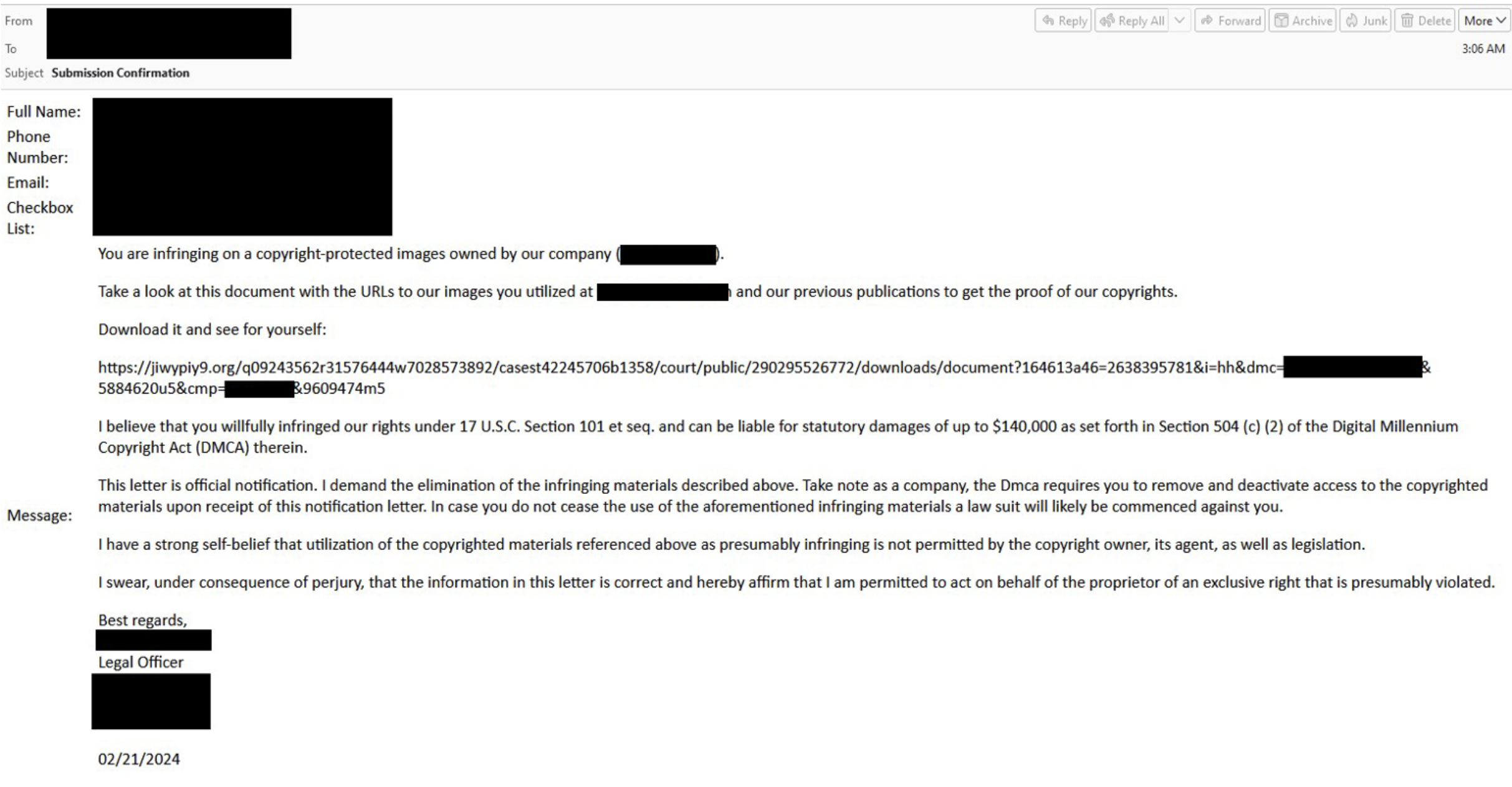
Figure 2: Example malicious contact form submission.
In recent years, TA578 favored IcedID and Bumblebee but has exclusively used Latrodectus as an initial access payload since its return to attributed email campaign data in December 2023.
Malware analysis
Latrodectus resolves Windows API functions dynamically by hash, checks for debuggers present, gathers operating system information, checks running processes, and checks to make sure the computer does not have an existing Latrodectus infection running. The malware will then attempt to install itself, set an AutoRun key, and create a scheduled task for persistence. Latrodectus will post encrypted system information to the command and control server (C2) and request the download of the bot. Once the bot registers with the C2, it sends requests for commands from the C2.
When the malware was first reported by Walmart in October 2023, there were direct references to downloading a file called “bp.dat”, which was confirmed to be the IcedID bot component. The malware itself has had a few small changes since its discovery, but overall, it is quite rudimentary.
Updated/downgraded? String decryption
A strange change recently observed in Latrodectus samples was a simplified string decryption routine. Generally, when malware updates string encryption, it’s to further complicate the algorithm, but in this case the opposite was done. String decryption was documented in the original Walmart blog, where the developers used a unique pseudo random number generator (PRNG) algorithm illustrated in Figure 3:
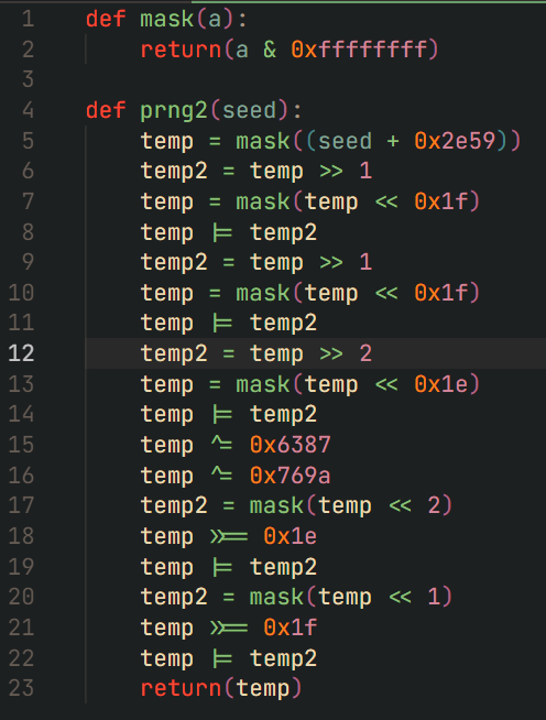
Figure 3: Original string decrypt PRNG from November 2023.
This PRNG was called each iteration of the decrypt loop to mutate the seed to decrypt the next byte of the string. In this latest version identified on 2 March 2023, the PRNG was replaced by an increment of the seed variable, leading to the following algorithm, which is now a rolling XOR key, as seen in Figure 4:
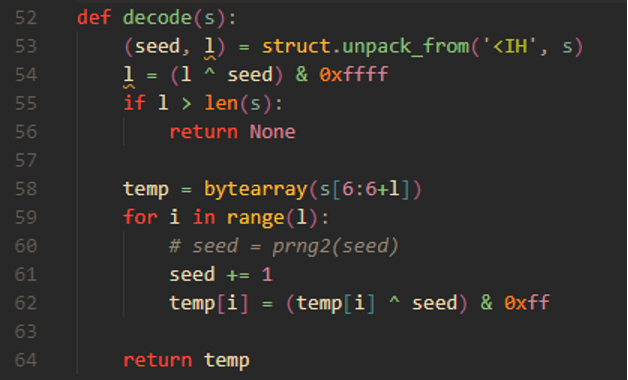
Figure 4: The current string decryption routine.
Malware initialization
The malware starts by resolving bulk APIs for various functions. After all the functions have been resolved to their global pointers, the malware ensures it is running in a suitable environment by performing virtualization checks. It checks the host for the following features, because the lack of these features generally indicates the sample is being run in a sandbox:
- If Windows 10 or newer, have at least 75 running processes
- If earlier than Windows 10, have at least 50 running processes
- Ensure the 64-bit application is running on a 64-bit host
- Ensure the host has a valid MAC address
These checks can be seen below:
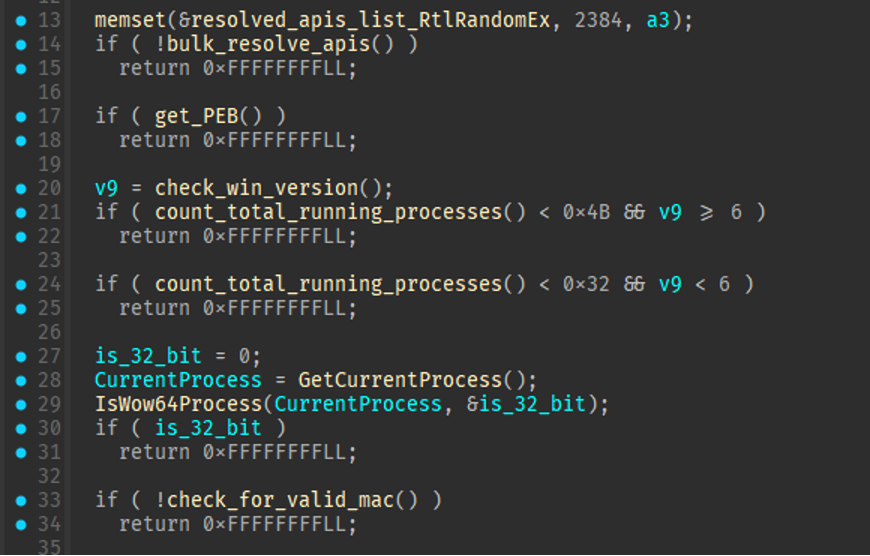
Figure 5: Environment checks.
In all the samples analyzed since the malware’s discovery, the malware always registers a mutex called “runnung” [sic]. If the mutex already exists, it indicates the host has an existing infection, and the malware will exit resulting in the new infection ending.

Figure 6: Mutex check.
With all the checks passed, the malware continues to initialize the variables for the campaign. This includes the current user’s username, a handle to its own file, a handle to the current process, and the campaign ID. The campaign ID (a string of letters) is hashed via FNV-1a to create the numeric campaign ID which is included in the communications protocol. In this sample, the campaign ID is based on the string “Supted” as seen in Figure 7.
Analyst note: Researching the techniques of string hashing of campaign IDs observed in Latrodectus helped researchers identify new patterns in previous IcedID campaigns. More on this in the below IcedID section.
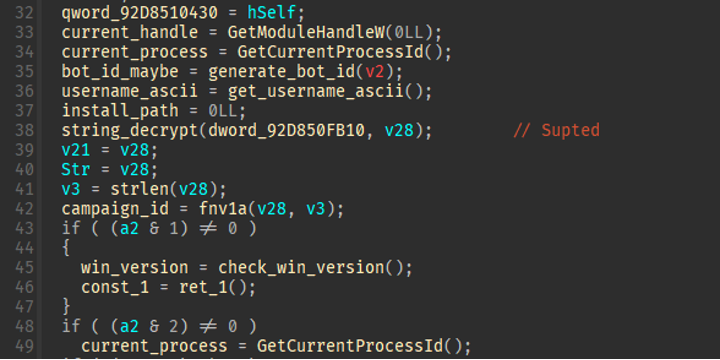
Figure 7: Global variable initialization.
Latrodectus generates bot IDs for each unique host the malware is installed on. Like IcedID, the bot ID is generated via the hosts’ serial ID. This serial is then passed to the bot ID creation function which multiplies the serial by a hardcoded constant, and returns the result and updates the serial to generate the next DWORD of the bot ID.
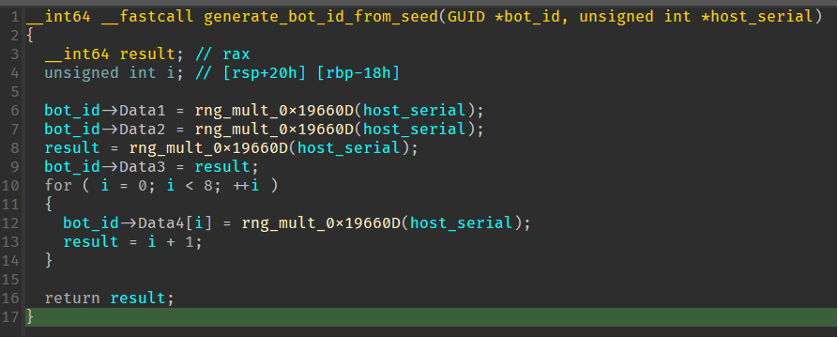
Figure 8: Bot ID generation.
This calculated value is then set in a format string to generate a string like:
D0ACE431ABCD00C7D41EF0BA04ED.

Figure 9: Bot ID to string.
C2 servers are decrypted, and set in the global configuration:
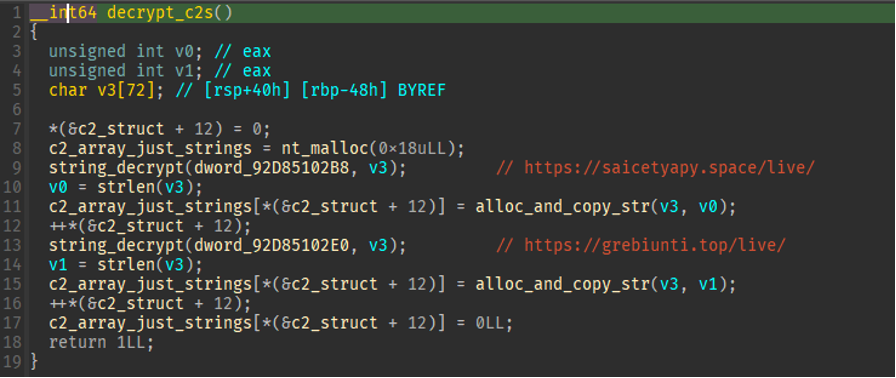
Figure 10: C2 decryption.
The malware then attempts to read a hardcoded filename “update_data.dat”, decrypt it, and set C2s from that file into the global list of C2s.

Figure 11: Checking the existence of update_data.dat and parsing it.
Before the malware starts communicating it needs to ensure it’s running from the designated location in %AppData%. This is a specific path that is derived from the bot ID. If the malware is not running out of this location, it copies itself to the new location, starts the new process and shuts down the current process.
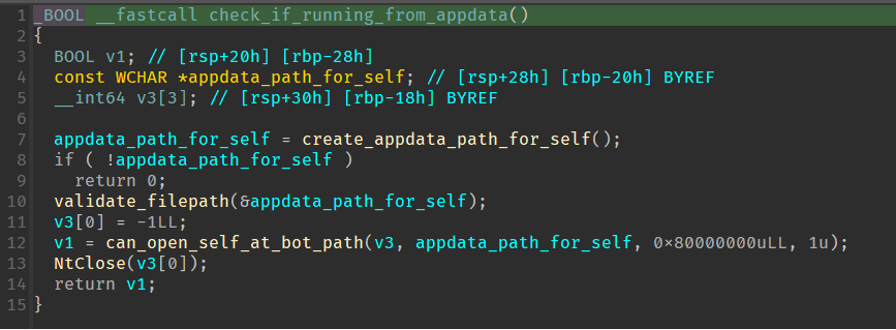
Figure 12: Code to determine whether the bot is running from its designated location in AppData.
At this point, the malware is either running from its designated location or is restarting itself in the new location. It creates a thread, which initiates the communications component of the malware.
Malware communication
Latrodectus, like IcedID, sends the registration information in a POST request where the fields are HTTP parameters concatenated together.
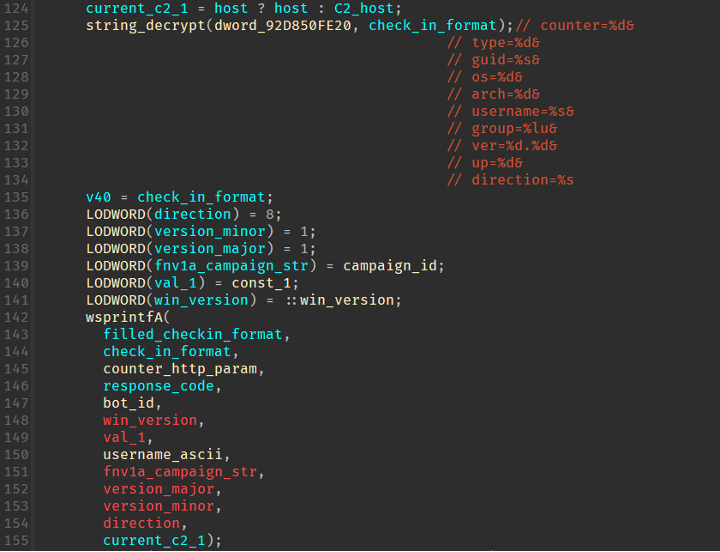
Figure 13: HTTP parameters being filled in.
An overview of each field can be seen below:
|
counter |
The number of HTTP requests made |
|
type |
1 for registration, 3 for system info |
|
guid |
Bot ID discussed earlier |
|
os |
Major version of the operating system |
|
arch |
1 if 64 bit |
|
username |
ASCII username |
|
group |
FNV-1a value of the campaign ID string ie: “Supted” |
|
ver |
Major and minor version (so far just 1.1) |
|
up |
An integer stored in the config that is different per sample |
Once this string is created, it is RC4 encrypted with the key “12345”. This key has been consistent across all samples analyzed to date. The resulting RC4 encrypted data is base64 encoded and sent to the C2 in the HTTP body.
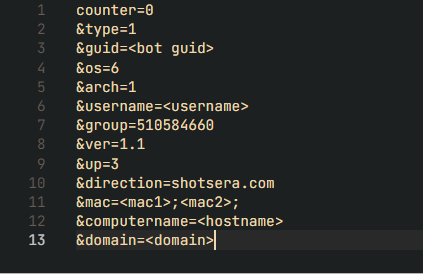
Figure 14: Sanitized cleartext request.
If the bot is coming from an IP that is not blocklisted and passed all other filtering, a response will be returned that, when decoded and decrypted with the global key “12345”, leads to a list of commands to be interpreted by the first command handler.
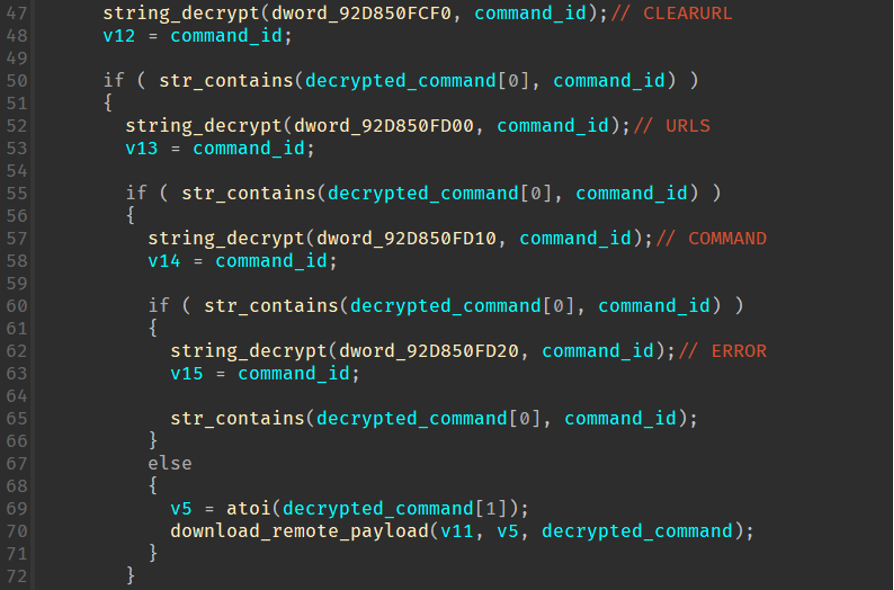
Figure 15: Command parsing for the first command handler.
The following table shows the four supported commands in the first command handler:
|
CLEARURL |
Reset the C2 table, removing all current C2s |
|
URLS |
Set the C2 with the given index |
|
COMMAND |
Internal command handler for common bot functionality |
|
ERROR |
Report an error to the bot |
An example response from the C2 is shown below. When decrypted and decoded gives commands within the above table:
E3l9I35LXiOWKYHilDWuJoUOTU3NOyjNGnp3muFUOrabzvFw6FpoOQqdBZmsUV5E7FzXWHKgBafR6PcPckBsIB2vIhb3CZ/QHPoEO1hc0A++PpLQjpRWJkK3EFDxH/R5RYjhInO8hc0jTljC91GMVstjkxgQnuZLGBW6AV/gz4VrNMWUxFUtP4fdg/HKCREbRm+gIHkH/7Jc9Q==
This response when base64 decoded and RC4 decrypted with the global key “12345” will show the following:

Figure 16: Decrypted and decoded command response.
The response is parsed by the major keywords. The URLs keyword replaces the C2s within the sample to the three listed in the command. When “COMMAND” is being processed, this triggers a second layer command handler. The handler first checks that the token after COMMAND is one of the expected command IDs. These commands support a feature that also exists within IcedID. These commands check for the existence of “front” in the string, which can be seen in figure 16 to load the sysinfo shellcode. This string is replaced with the currently active C2, with the string “/files/” appended. For Example, the file “sysinfo.bin” would be downloaded from popfealt[.]one/files/sysinfo.bin.
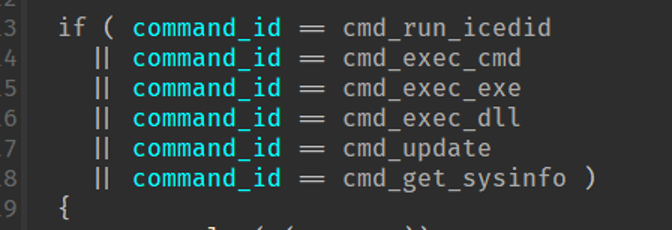
Figure 17: Command ID checking.
The commands Latrodectus supports currently:
|
Enum name |
Enum value |
Description |
|
cmd_get_desktop_items |
2 |
Get the filenames of files on the desktop |
|
cmd_get_proclist |
3 |
Get the list of running processes |
|
cmd_get_sysinfo |
4 |
Send additional system information |
|
cmd_exec_exe |
12 |
Execute executable |
|
cmd_exec_dll |
13 |
Execute DLL with given export |
|
cmd_exec_cmd |
14 |
Pass string to cmd and execute |
|
cmd_update |
15 |
Update the bot and trigger a restart |
|
cmd_kill |
17 |
Shutdown the running process |
|
cmd_run_icedid |
18 |
Download bp.dat and execute |
|
cmd_change_timing |
19 |
Set a flag to reset the communications timing |
|
cmd_reset_counter |
20 |
Reset the counter variable used in communications |
Although the malware supports “cmd_run_icedid” to download and execute “bp.dat”, Proofpoint has not observed Latrodectus dropping IcedID as a follow-on payload.
Ultimately, Latrodectus is a generic loader that appears to be in active development, but so far there have not been groundbreaking changes to its capabilities.
Latrodectus infrastructure
Tier 1 analysis
Team Cymru’s research into Latrodectus infrastructure began in late 2023 with the identification of four Tier 1 Command and Control (C2) servers in the initial October 2023 campaign. At the time, analysis of network telemetry (NetFlow) data for these C2s highlighted no discernible upstream communication with a possible Tier 2 (T2) proxy server. However, the IPs shared several common characteristics, which were leveraged to find other C2s and subsequently identify upstream T2 communication, as described below.
Queries for the combined characteristics detailed below resulted in less than one hundred IPs being returned, a positive sign that the results were broadly related, as the existence of hundreds of C2s would be unlikely at this point.
Fingerprint Hash = 2ad2ad16d2ad2ad22c2ad2ad2ad2ad89cd2abd9b188d3b42762a4c6aa7ff72
Open Ports= 8080, 443
Open Ports Banner Hash = eb51f3b6b62c69672dbeced9ce2252675db44222, 9b5ee969ca96ba0d4547a6041c5a86bf80fd4c96
Open Ports Banner = 403 Forbidden, localhost
Filtering out false positives, mostly belonging to Amazon and Russian provider IP space, the remaining IPs were assigned to hosting providers often utilized for C2 infrastructure by IcedID and other dropper malware. This list includes familiar AS names such as BLNWX, BV-EU-AS, LITESERVER, MIRHOSTING, XHOST, ZAPPIE-HOST, and ZERGRUSH.
Indications of a potential T2 server were found in NetFlow data for these potential C2s, with numerous C2s initiating communication with this IP on remote TCP/80. Further investigation of this IP led to the identification of additional C2s based on matching traffic patterns. Although Latrodectus uses domains concealed behind Cloudflare in its malware configurations, Team Cymru confirmed that many of the C2s found communicating with the T2 were the true IPs behind these domains.
C2 lifespan
The chart below illustrates the lifespan of Latrodectus C2s, helping to highlight patterns in C2 activity including gaps, turnover rates, and concurrent live C2s. The timeline starts 18 September 2023, incrementing bi-weekly through March 2024. Vertical lines mark each Sunday, while red bars represent individual C2s, ordered by first appearance. A bar's length reflects its lifespan, from the start to the end of communication with the T2.
By focusing on T2 communications, rather than victim communications or when a C2 first appeared in the wild, it is possible to provide a more accurate representation of lifespan based on utilization by the threat actor(s).
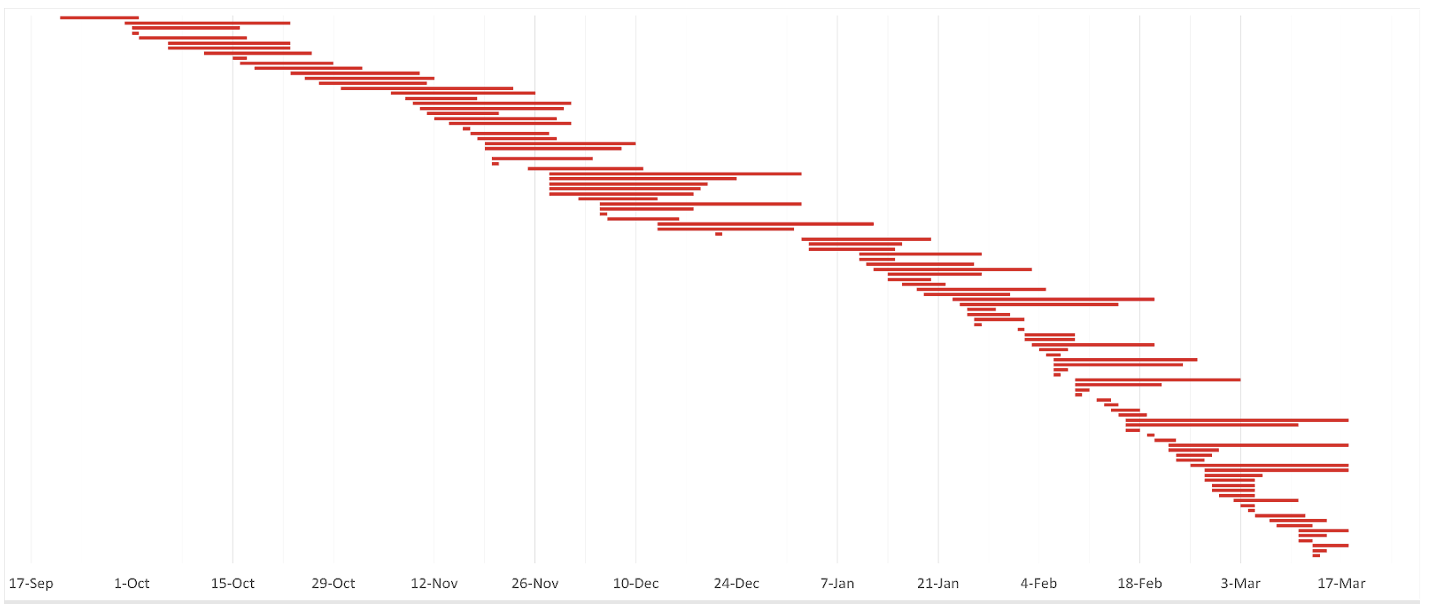
Figure 18: Latrodectus C2 timeline from September 2023 through Mach 2024.
Since tracking began, Team Cymru has observed an ongoing cycle of C2 activity, starting with the first C2 to T2 connection in September. This continued even during the January 2024 “quiet phase” when no campaigns were publicly identified. With malspam campaigns resuming in early February 2024, the activities in January 2024 may represent testing phases, targeted attacks, or the use alternative distribution methods beyond malspam.
The chart indicates multiple patterns; the October to December 2023 campaigns coincided with C2s having longer lifespans, while the few C2s in September 2023 are likely linked to testing prior to the initial campaigns being observed in the wild. After a decline in December, the creation of new C2s resumed in January 2024, leading to more frequent but often shorter-lived C2s since then.
Pivoting to raw data, analysis from 1 January to 18 March 2024 shows a C2 setup rate of one every 1.18 days, double the previous rate from 21 September to 31 December 2023 of one every 2.32 days. The average lifespan of C2s during the January to March 2024 period dropped to nine days, compared to an average of fifteen days for September to December 2023. One explanation for these changes could be that the threat actors are intensifying Latrodectus operations, having spent the late 2023 period testing the waters.
As previously referenced, each vertical line on the chart above (Figure 18) represents a Sunday / beginning of a new week, offering a high-level view of when new infrastructure is typically established. Initial analysis did not identify a preferred day on which C2s were set up, although a decrease in activity was noted to occur on weekends.

Figure 19: Analysis of preferred day of C2 creation.
Further analysis of the raw data indicated, however, that new C2s initiate communication with the T2 primarily on Fridays, perhaps to prepare infrastructure for the upcoming working week on Monday. Setup rates on Tuesday, Wednesday, and Thursday are comparably high, while Monday rates are lower. As mentioned above, activity drops over the weekend, suggesting the threat actors generally take this time off (as is often seen in analysis of cybercrime threat actors).
Tier 2 analysis
Based on historic network telemetry data, the T2 server was set up around August 2023. It has an X.509 certificate subject value that was also associated with BazarLoader C2s in 2021.
Since the initial setup of the Latrodectus infrastructure, only a few other IPs were found sharing this X.509 certificate. We suspect one such IP hosts a development server that first appeared active in July 2023, a month prior to the T2, while the roles of the others remain unclear. Nonetheless, Team Cymru is confident in their association with Latrodectus.
Beyond the development server, researchers identified other notable components within the Latrodectus infrastructure. Team Cymru has pinpointed hosts that exhibit patterns indicative of operator activity based on their consistent interactions across the infrastructure, including with the development server, and their assessed usage of services and tools known to be applicable to cybercrime-related activities.
Additional hosts were found within the infrastructure, but their specific roles remain undefined. However, based on traffic patterns and other traits that resemble that of other confirmed infrastructure, researchers can assume that they are interesting and should be monitored.
Any unknowns in the infrastructure continue to be a focus of Team Cymru’s investigations and researchers will provide updates when further information becomes known, as appropriate.
Connection to IcedID
From an infrastructure analysis perspective, Team Cymru determined that the same threat actors responsible for IcedID are also involved in the operation of Latrodectus. This conclusion is drawn from a few key observations. For one, the C2 hosting choices between the two operations are similar, as mentioned above, although this alone is not a strong association.
More conclusively, the Latrodectus T2 maintains connections with backend infrastructure associated with IcedID, and operator activity within Latrodectus infrastructure includes the utilization of specific jumpboxes known to be used in IcedID operations.

Figure 20: Latrodectus infrastructure related to IcedID infrastructure.
The use of these hosts by operators for both IcedID and Latrodectus activities has been consistent since the initial setup of the Latrodectus management infrastructure in July/August 2023.
Standard IcedID update: a mystery decrypted
While investigating the techniques used in string hashing related to Latrodectus campaign IDs, Proofpoint researchers applied similar techniques to brute-force previously observed IcedID campaign IDs to derive a meaningful string. Researchers identified patterns in the brute-forced IcedID campaign IDs and correlated them to specific threat actor campaigns over time. The correlation suggests that in most cases, the derived IcedID campaign IDs associated with each threat actor follow specific themes, such as cars or geographic regions.
IcedID is a malware originally classified as a banking trojan and was first observed in 2017. It also acts as a loader for other malware, including ransomware. As previously published, historically there has been just one version of IcedID that has remained constant since 2017. This well-known IcedID version, now commonly known as "Standard IcedID" to differentiate it from newer variants, consists of two main components:
- IcedID loader: The loader is distributed initially, used to contact a Loader C2 server and attempt to download the second component, the core IcedID Bot.
- IcedID bot: The core module containing most of the malware functionality.
Most malware contains a configuration which is often used to input details specific to a threat actor. These details will differentiate affiliates in the malware panel and determine what malware infections the group can see and further leverage. It is common across most malware families for a form of project or campaign ID to distinguish the user affiliated with the malware infection.
The IcedID loader and bot have different campaign IDs and C2s. Historically, both the campaign ID and the C2 found in the IcedID loader configuration was typically distinct for each campaign and could be used to cluster related activity and aid in threat actor attribution. In 2022, a change occurred in campaign activity which made the loader's configuration unreliable for delineating between campaigns and threat actors. Despite the change to the loader, the IcedID bot configuration remained consistent and generally unique to a threat actor.

Figure 21: Example IcedID Configuration in a September 2023 TA577 campaign.
In late 2023, Proofpoint researchers used the FNV-1a hashing algorithm to brute-force IcedID bot campaign IDs, which allowed insight and correlation to campaigns and aid in confident attribution of previously suspected threat actor activity. The numbers used as campaign IDs resolved to words and brands that were used by specific IcedID affiliates. This was the first time researchers had observed successful derivation of the campaign IDs, and the strings resolved were notable. Many affiliates associated with a threat actor appear to have a “theme” for their campaign IDs. For example, TA578 campaign IDs generally used an automobile theme like “Pontiac” or “Hyundai”. TA544 campaign IDs contained Italian references. TA579 campaign IDs supported a previously suspected relationship distributing for another threat actor. TA551 campaign IDs often referenced the NATO phonetic alphabet, though there were anomalies and not enough data to assert with confidence. TA581 campaign IDs had no unique patterns which supports the suspicion that the actor is solely a distributor or overlaps with another threat group. The patterns that emerged correlating specific threat actors to certain themes proved consistent over years.
By identifying campaign ID patterns that proved consistent for each threat actor over years of IcedID campaign activity, in addition to other campaign indicators, researchers were able to attribute activity with high confidence to tracked threat actors, despite the change in loader configuration in 2022. It also provided valuable insight into how botnet operators monitor affiliates, and further illustrated that seemingly random identifiers often provide important data that can assist in attribution, potentially including future Latrodectus campaigns.
The data represented in this update was collected between 2022 and 2023. The patterns and hypothesis formed are limited to the malware configuration data collected from aproximately 100 campaigns originating from email during this scope of time and the subset of campaign IDs successfully decrypted. While Proofpoint is planning to publish a more thorough analysis of the patterns and campaign IDs in relation to tracked threat actors, below is a table of select project IDs initially brute forced:
|
Decoded Project ID |
Original Project ID |
|
Ascari |
3524611504 |
|
Atilda |
2585978814 |
|
Austin |
3919082043 |
|
Buick |
2056920153 |
|
Caprese |
3036889562 |
|
Chery |
1057461280 |
|
Chevrolet |
904247735 |
|
Delta |
1023147713 |
|
Devlin |
3393436303 |
|
Echo |
998075300 |
|
Fullmoon |
3415411565 |
|
Hyundai |
2262657793 |
|
India |
2646410796 |
|
Italdesign |
3681413287 |
|
Juliet |
2941939166 |
|
Jupiter |
921805286 |
|
Kappa |
2143020712 |
|
Kilo |
686741504 |
|
Lincoln |
1573268852 |
|
Mars |
1180344712 |
|
Mike |
4049493703 |
|
Pontiac |
1501064257 |
|
Porsche |
310022019 |
Conclusion
Proofpoint anticipates Latrodectus will become increasingly used by threat actors across the landscape, especially by those who previously delivered IcedID. Given its use by threat actors assessed to be initial access brokers, defenders are encouraged to understand the tactics, techniques, and procedures (TTPs) exhibited by the malware and associated campaigns.
Latrodectus’ attempts to incorporate sandbox evasion functionality aligns with the trend overall in the cybercrime threat landscape that malware authors are increasingly trying to bypass defenders and ensure only potential victims receive the payload. Proofpoint has observed similar attempts from other notable malware used by IABs including Pikabot and WikiLoader.
Emerging Threats signatures
2051602 ET MALWARE Latrodectus Related Activity (POST)
2051601 ET MALWARE Observed Latrodectus Domain (popfealt .one in TLS SNI)
2051600 ET MALWARE Observed Latrodectus Domain (aytobusesre .com in TLS SNI)
2051599 ET MALWARE DNS Query to Latrodectus Domain (popfealt .one)
2051598 ET MALWARE DNS Query to Latrodectus Domain (aytobusesre .com)
2049706 ET MALWARE Latrodectus Alive Response M8
2049705 ET MALWARE Latrodectus Alive Response M7
2049704 ET MALWARE Latrodectus Alive Response M6
2049703 ET MALWARE Latrodectus Alive Response M5
2049702 ET MALWARE Latrodectus Alive Response M4
2049701 ET MALWARE Latrodectus Alive Response M3
2049700 ET MALWARE Latrodectus Alive Response M2
2049233 ET MALWARE Latrodectus 404 Response
2049232 ET MALWARE Latrodectus Alive Response M1
2049231 ET MALWARE Latrodectus Alive Request (GET)
2048735 ET MALWARE Latrodectus Loader Related Activity (POST)
Indicators of compromise
|
Indicator |
Description |
First Observed |
|
db03a34684feab7475862080f59d4d99b32c74d3a152a53b257fd1a443e8ee77 |
LNK Payload SHA256 |
27 November 2023 |
|
e99f3517a36a9f7a55335699cfb4d84d08b042d47146119156f7f3bab580b4d7
|
DLL Payload SHA256 |
27 November 2023 |
|
hxxps://mazdakrichest[.]com/live/ |
Latrodectus C2 |
27 November 2023 |
|
hxxps://riverhasus[.]com/live/ |
Latrodectus C2 |
27 November 2023 |
|
bb525dc6b7a7ebefd040e01fd48d7d4e178f8d9e5dec9033078ced4e9aa4e241 |
JavaScript Payload SHA256 |
28 November 2023 |
|
97e093f2e0bf6dec8392618722dd6b4411088fe752bedece910d11fffe0288a2 |
DLL Payload SHA256 |
28 November 2023 |
|
hxxp://162[.]55[.]217[.]30/gRMS/0[.]6395541546258323[.]dat |
JavaScript Payload URL |
28 November 2023 |
|
hxxp://157[.]90[.]166[.]88/O3ZlYNW/0[.]7797109211833805[.]dat |
JavaScript Payload URL |
28 November 2023 |
|
hxxp://128[.]140[.]36[.]37/cQtDIo/0[.]43650426987684443[.]dat |
JavaScript Payload URL |
28 November 2023 |
|
hxxps://peermangoz[.]me/live/ |
Latrodectus C2 |
28 November 2023 |
|
hxxps://aprettopizza[.]world/live/ |
Latrodectus C2 |
28 November 2023 |
|
hxxps://nimeklroboti[.]info/live/ |
Latrodectus C2 |
28 November 2023 |
|
hxxps://frotneels[.]shop/live/ |
Latrodectus C2 |
28 November 2023 |
|
f9c69e79e7799df31d6516df70148d7832b121d330beebe52cff6606f0724c62 |
JavaScript Payload SHA256 |
24 November 2023 |
|
d9471b038c44619739176381815bfa9a13b5ff77021007a4ede9b146ed2e04ec |
DLL Payload SHA256 |
24 November 2023 |
|
hxxps://hukosafaris[.]com/elearning/f/q/daas-area/chief/index[.]php |
JavaScript Payload URL |
24 November 2023 |
|
d98cd810d568f338f16c4637e8a9cb01ff69ee1967f4cfc004de3f283d61ba81 |
DLL Payload SHA256 |
14 December 2023 |
|
47d66c576393a4256d94f5ed1e77adc28426dea027f7a23e2dbf41b93b87bd78 |
EXE Payload SHA256 |
14 December 2023 |
|
77[.]91[.]73[.]187:443 |
DanaBot C2 IP Address |
14 December 2023 |
|
74[.]119[.]193[.]200:443 |
DanaBot C2 IP Address |
14 December 2023 |
|
hxxps://arsimonopa[.]com/live |
Latrodectus C2 |
14 December 2023 |
|
hxxps://lemonimonakio[.]com/live |
Latrodectus C2 |
14 December 2023 |
|
bb525dc6b7a7ebefd040e01fd48d7d4e178f8d9e5dec9033078ced4e9aa4e241 |
JavaScript Payload SHA256 |
1 February 2024 |
|
5d881d14d2336273e531b1b3d6f2d907539fe8489cbe80533280c9c72efa2273 |
DLL Payload SHA256 |
1 February 2024 |
|
hxxp://superior-coin[.]com/ga/index[.]php |
JavaScript Payload URL |
1 February 2024 |
|
hxxp://superior-coin[.]com/ga/m/6[.]dll |
JavaScript Payload URL |
1 February 2024 |
|
hxxps://fluraresto[.]me/live/ |
Latrodectus C2 |
1 February 2024 |
|
hxxps://mastralakkot[.]live/live/ |
Latrodectus C2 |
1 February 2024 |
|
hxxps://postolwepok[.]tech/live/ |
Latrodectus Update URLs |
1 February 2024 |
|
hxxps://trasenanoyr[.]best/live/ |
Latrodectus Update URLs |
1 February 2024 |
|
10c129e2310342a55df5fa88331f338452835790a379d5230ee8de7d5f28ea1a |
JavaScript Payload SHA256 |
5 February 2024 |
|
781c63cf4981fa6aff002188307b278fac9785ca66f0b6dfcf68adbe7512e491 |
MSI Payload SHA256 |
5 February 2024 |
|
aa29a8af8d615b1dd9f52fd49d42563fbeafa35ff0ab1b4afc4cb2b2fa54a119 |
DLL Payload SHA256 |
5 February 2024 |
|
0ac5030e2171914f43e0769cb10b602683ccc9da09369bcd4b80da6edb8be80e |
JavaScript Payload SHA256 |
9 February 2024 |
|
0e96cf6166b7cc279f99d6977ab0f45e9f47e827b8a24d6665ac4c29e18b5ce0
|
MSI Payload SHA256 |
9 February 2024 |
|
77270e13d01b2318a3f27a9a477b8386f1a0ebc6d44a2c7e185cfbe55aac8017 |
DLL Payload SHA256 |
9 February 2024 |
|
hxxps://miistoria[.]com/live |
Latrodectus C2 |
9 February 2024 |
|
hxxps://plwskoret[.]top/live |
Latrodectus C2 |
9 February 2024 |
|
e7ff6a7ac5bfb0bb29547d413591abc7628c7d5576a3b43f6d8e5d95769e553a |
JavaScript Payload SHA256 |
13 February 2024 |
|
dedbc21afc768d749405de535f9b415baaf96f7664ded55d54829a425fc61d7e |
MSI Payload SHA256 |
13 February 2024 |
|
378d220bc863a527c2bca204daba36f10358e058df49ef088f8b1045604d9d05 |
DLL Payload SHA256 |
13 February 2024 |
|
edeacd49aff3cfea35d593e455f7caca35ac877ad6dc19054458d41021e0e13a
|
JavaScript Payload SHA256 |
20 February 2024 |
|
9c27405cf926d36ed8e247c17e6743ac00912789efe0c530914d7495de1e21ec |
MSI Payload SHA256 |
20 February 2024 |
|
9a8847168fa869331faf08db71690f24e567c5cdf1f01cc5e2a8d08c93d282c9 |
DLL Payload SHA256 |
20 February 2024 |
|
hxxp://178[.]23[.]190[.]199:80/share/gsm[.]msi |
JavaScript WebDAV Payload URL |
20 February 2024 |
|
hxxps://sluitionsbad[.]tech/live/ |
Latrodectus C2 |
20 February 2024 |
|
hxxps://grebiunti[.]top/live/ |
Latrodectus C2 |
20 February 2024 |
|
856dfa74e0f3b5b7d6f79491a94560dbf3eacacc4a8d8a3238696fa38a4883ea |
JavaScript Payload SHA256 |
23 February 2024 |
|
88573297f17589963706d9da6ced7893eacbdc7d6bc43780e4c509b88ccd2aef |
MSI Payload SHA256 |
23 February 2024 |
|
97e08d1c7970c1c12284c4644e2321ce41e40cdaac941e451db4d334cb9c5492 |
DLL Payload SHA256 |
23 February 2024 |
|
hxxp://5[.]252[.]21[.]207@80/share/escape[.]msi |
JavaScript WebDAV Payload URL |
23 February 2024 |
|
hxxps://zumkoshapsret[.]com/live/ |
Latrodectus C2 |
23 February 2024 |
|
hxxps://jertacco[.]com/live/ |
Latrodectus C2 |
23 February 2024 |
|
60c4b6c230a40c80381ce283f64603cac08d3a69ceea91e257c17282f66ceddc |
JavaScript Payload SHA256 |
27 February 2024 |
|
88573297f17589963706d9da6ced7893eacbdc7d6bc43780e4c509b88ccd2aef |
MSI Payload SHA256 |
27 February 2024 |
|
97e08d1c7970c1c12284c4644e2321ce41e40cdaac941e451db4d334cb9c5492
|
DLL Payload SHA256 |
27 February 2024 |
|
hxxp://5[.]252[.]21[.]207/share/escape[.]msi |
JavaScript WebDAV Payload URL |
27 February 2024 |
|
a189963ff252f547fddfc394c81f6e9d49eac403c32154eebe06f4cddb5a2a22 |
JavaScript Payload SHA256 |
4 March 2024 |
|
aee22a35cbdac3f16c3ed742c0b1bfe9739a13469cf43b36fb2c63565111028c
|
DLL Payload SHA256 |
4 March 2024 |
|
hxxp://95[.]164[.]3[.]171/share/cisa[.]msi |
WebDAV Payload URL |
4 March 2024 |
|
hxxps://scifimond[.]com/live/ |
Latrodectus C2 |
4 March 2024 |
|
hxxps://aytobusesre[.]com/live/ |
Latrodectus C2 |
4 March 2024 |
|
4416b8c36cb9d7cc261ff6612e105463eb2ccd4681930ca8e277a6387cb98794 |
JavaScript Payload SHA256 |
7 March 2024 |
|
aee22a35cbdac3f16c3ed742c0b1bfe9739a13469cf43b36fb2c63565111028c |
DLL Payload SHA256 |
7 March 2024 |
|
hxxps://popfealt[.]one/live/ |
Latrodectus Update URLs |
7 March 2024 |
|
hxxps://ginzbargatey[.]tech/live/ |
Latrodectus Update URLs |
7 March 2024 |
|
hxxps://minndarespo[.]icu/live/ |
Latrodectus Update URLs |
7 March 2024 |
|
090f2c5abb85a7b115dc25ae070153e4e958ae4e1bc2310226c05cd3e9429446 |
JavaScript Payload SHA256 |
11 March 2024 |
|
ee1e5b80a1d3d47c7703ea2b6b64ee96283ab3628ee4fa1fef6d35d1d9051e9f |
MSI Payload SHA256 |
11 March 2024 |
|
3b63ea8b6f9b2aa847faa11f6cd3eb281abd9b9cceedb570713c4d78a47de567 |
DLL Payload SHA256 |
11 March 2024 |
|
hxxps://drifajizo[.]fun/live/ |
Latrodectus C2 |
11 March 2024 |
|
hxxps://scifimond[.]com/live/ |
Latrodectus C2 |
11 March 2024 |
|
hxxps://minndarespo[.]icu/live/ |
Latrodectus C2 |
11 March 2024 |
|
6904d382bc045eb9a4899a403a8ba8a417d9ccb764f6e0b462bc0232d3b7e7ea |
JavaScript Payload SHA256 |
18 March 2024 |
|
71fb25cc4c05ce9dd94614ed781d85a50dccf69042521abc6782d48df85e6de9 |
DLL Payload SHA256 |
18 March 2024 |
|
hxxp://sokingscrosshotel[.]com/share/upd[.]msi |
WebDAV Payload URL |
18 March 2024 |
|
hxxps://titnovacrion[.]top/live/ |
Latrodectus C2 |
18 March 2024 |

